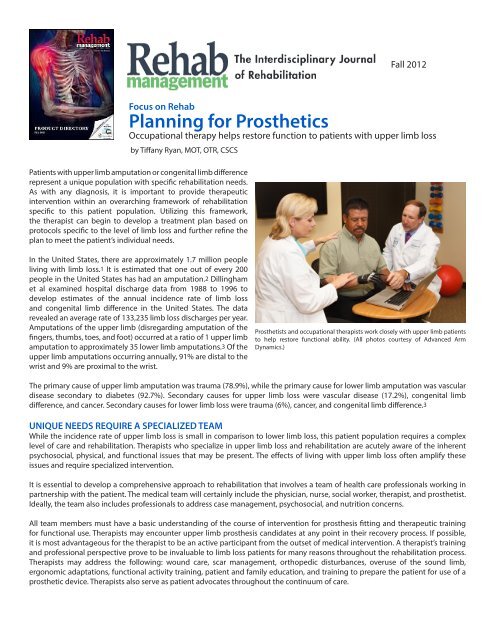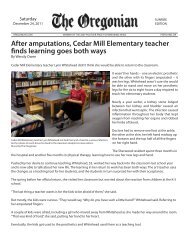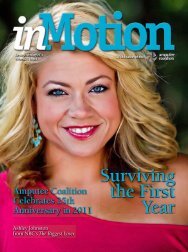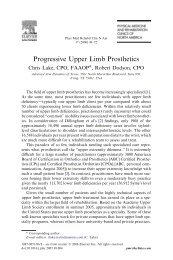Planning for Prosthetics - Advanced Arm Dynamics
Planning for Prosthetics - Advanced Arm Dynamics
Planning for Prosthetics - Advanced Arm Dynamics
Create successful ePaper yourself
Turn your PDF publications into a flip-book with our unique Google optimized e-Paper software.
Fall 2012<br />
Focus on Rehab<br />
<strong>Planning</strong> <strong>for</strong> <strong>Prosthetics</strong><br />
Occupational therapy helps restore function to patients with upper limb loss<br />
by Tiffany Ryan, MOT, OTR, CSCS<br />
Patients with upper limb amputation or congenital limb difference<br />
represent a unique population with specific rehabilitation needs.<br />
As with any diagnosis, it is important to provide therapeutic<br />
intervention within an overarching framework of rehabilitation<br />
specific to this patient population. Utilizing this framework,<br />
the therapist can begin to develop a treatment plan based on<br />
protocols specific to the level of limb loss and further refine the<br />
plan to meet the patient’s individual needs.<br />
In the United States, there are approximately 1.7 million people<br />
living with limb loss.1 It is estimated that one out of every 200<br />
people in the United States has had an amputation.2 Dillingham<br />
et al examined hospital discharge data from 1988 to 1996 to<br />
develop estimates of the annual incidence rate of limb loss<br />
and congenital limb difference in the United States. The data<br />
revealed an average rate of 133,235 limb loss discharges per year.<br />
Amputations of the upper limb (disregarding amputation of the<br />
fingers, thumbs, toes, and foot) occurred at a ratio of 1 upper limb<br />
amputation to approximately 35 lower limb amputations.3 Of the<br />
upper limb amputations occurring annually, 91% are distal to the<br />
wrist and 9% are proximal to the wrist.<br />
Prosthetists and occupational therapists work closely with upper limb patients<br />
to help restore functional ability. (All photos courtesy of <strong>Advanced</strong> <strong>Arm</strong><br />
<strong>Dynamics</strong>.)<br />
The primary cause of upper limb amputation was trauma (78.9%), while the primary cause <strong>for</strong> lower limb amputation was vascular<br />
disease secondary to diabetes (92.7%). Secondary causes <strong>for</strong> upper limb loss were vascular disease (17.2%), congenital limb<br />
difference, and cancer. Secondary causes <strong>for</strong> lower limb loss were trauma (6%), cancer, and congenital limb difference.3<br />
UNIQUE NEEDS REQUIRE A SPECIALIZED TEAM<br />
While the incidence rate of upper limb loss is small in comparison to lower limb loss, this patient population requires a complex<br />
level of care and rehabilitation. Therapists who specialize in upper limb loss and rehabilitation are acutely aware of the inherent<br />
psychosocial, physical, and functional issues that may be present. The effects of living with upper limb loss often amplify these<br />
issues and require specialized intervention.<br />
It is essential to develop a comprehensive approach to rehabilitation that involves a team of health care professionals working in<br />
partnership with the patient. The medical team will certainly include the physician, nurse, social worker, therapist, and prosthetist.<br />
Ideally, the team also includes professionals to address case management, psychosocial, and nutrition concerns.<br />
All team members must have a basic understanding of the course of intervention <strong>for</strong> prosthesis fitting and therapeutic training<br />
<strong>for</strong> functional use. Therapists may encounter upper limb prosthesis candidates at any point in their recovery process. If possible,<br />
it is most advantageous <strong>for</strong> the therapist to be an active participant from the outset of medical intervention. A therapist’s training<br />
and professional perspective prove to be invaluable to limb loss patients <strong>for</strong> many reasons throughout the rehabilitation process.<br />
Therapists may address the following: wound care, scar management, orthopedic disturbances, overuse of the sound limb,<br />
ergonomic adaptations, functional activity training, patient and family education, and training to prepare the patient <strong>for</strong> use of a<br />
prosthetic device. Therapists also serve as patient advocates throughout the continuum of care.
PROSTHETIC REHABILITATION LEADS TO AN ACTIVE LIFE<br />
Upper limb loss secondary to traumatic injury is often the result of on-the-job accidents. Shawn Findley was working on a punch<br />
press in an industrial fabrication shop when a portion of his hand was amputated by a machine. In an attempt to save what remained<br />
of his injured hand, Findley endured 13 surgical procedures, only to still be faced with persistent pain and a partial hand that offered<br />
minimal function. He consulted with an upper limb prosthetist and occupational therapist to learn about the prosthetic options that<br />
would be available if he decided to have the injured hand amputated.<br />
Three years after his injury, Findley decided to have his hand amputated. This was the pivotal point in his return to a productive<br />
and fulfilling lifestyle. Once this decision was made, his surgeon, prosthetist and OT collaborated with him to discuss his functional<br />
goals and how he saw himself using a prosthesis. He determined that he would benefit from a myoelectric prosthesis with a custom<br />
cosmetic covering <strong>for</strong> many of his activities of daily living. He also chose an activity specific device to enable him to participate in<br />
coaching soccer, baseball and basketball <strong>for</strong> his children again.<br />
It is ideal to engage in this collaborative process prior to amputation and provide in<strong>for</strong>mation to the surgeon to determine the<br />
optimal level of amputation <strong>for</strong> successful prosthesis use. Preserving length is not always the surgeon’s guide. Other important<br />
considerations include allowing room <strong>for</strong> use of prosthetic components and the patient’s ability to activate <strong>for</strong>earm muscles <strong>for</strong><br />
myoelectric control.<br />
Findley’s OT tested and identified adequate myoelectric muscle sites (wrist extensors and flexors) and began training the muscles<br />
<strong>for</strong> use. After an extended period of inactivity, Findley’s muscles had atrophied considerably. Training muscle facilitation be<strong>for</strong>e and<br />
after amputation strengthened these muscles <strong>for</strong> independent control of opening and closing a terminal device once he was fit<br />
with his first prosthesis.<br />
After amputation and preparatory prosthesis training, Findley was pain-free and began to gain more independence in self-care and<br />
higher level bi-manual tasks.<br />
GENERAL REHABILITATION FRAMEWORK<br />
The upper limb prosthetic rehabilitation process is organized into broad segments that help give focus and continuity to the longterm<br />
treatment plan. These segments are not finite and may overlap. Smurr et al characterize these stages as follows:
PROSTHETIC REHABILITATION HELPS RESTORE INDEPENDENCE<br />
In cases of bilateral upper limb loss, prosthetic rehabilitation is critical to restoring some degree of independence to the patient.<br />
During the initial stage of rehabilitation, without one sound hand to assist them in their daily life, the patient is completely dependent<br />
on someone else <strong>for</strong> their most basic and personal needs such as toileting, bathing, dressing, and eating.<br />
Electrical lineman Cliff Anderson experienced bilateral arm amputation at the shoulder in January 2012 after he was electrocuted<br />
while working at a trans<strong>for</strong>mer station. Comorbidities include severe burns and scarring, partial blindness, and incomplete spinal<br />
cord injury that impact his balance and ability to walk. Anderson spent more than 6 months in the hospital. His case manager<br />
arranged <strong>for</strong> an upper limb prosthetist and occupational therapist to collaborate with inpatient therapists to better prepare<br />
Anderson <strong>for</strong> prosthetic rehabilitation.<br />
In July, Anderson was released to return home and begin prosthetic fitting and rehabilitation. Over the course of 1 week, he had<br />
myosite training, an expedited prosthetic fitting, and basic prosthesis training, and went home with a functional preparatory<br />
prosthesis on his left side. Anderson was able to pick up a cup of water and bring the straw to his lips <strong>for</strong> a drink <strong>for</strong> the first time<br />
since his accident; he also peeled and ate a banana. His occupational therapist has completed a home assessment to suggest<br />
modifications that would enable Anderson to become more independent. His prosthetic rehabilitation will continue with fitting a<br />
preparatory prosthesis on his right side, more basic prosthetic training and, eventually, advanced prosthetic training that can lead<br />
to significant increases in independence and personal mobility.<br />
“Ultimately, I am hoping <strong>for</strong> activity-specific prostheses that help me get back out to work in my shop and mess around with cars,”<br />
Anderson says.<br />
IN CONCLUSION<br />
Across the stages of upper limb prosthetic rehabilitation, occupational therapists are addressing psychosocial concerns, residual<br />
limb changes, and other physical issues that fluctuate throughout the healing process. The challenges therapists face may include<br />
the traumatic nature of the loss, the need <strong>for</strong> a comprehensive team approach, and limited access to medical professionals who<br />
are knowledgeable in caring <strong>for</strong> this relatively small patient population. It is beneficial to enlist input from resources with extensive<br />
experience in treating upper limb loss patients in overcoming some of the unique obstacles these patients face.<br />
In most cases, people with upper limb loss or difference are active and productive individuals. The broad range of needs these<br />
patients present offer therapists a challenging and exceedingly fulfilling professional experience.<br />
Tiffany Ryan, MOT, OTR, CSCS, has 15 years of professional experience. She is the national director of therapeutic services <strong>for</strong> <strong>Advanced</strong><br />
<strong>Arm</strong> <strong>Dynamics</strong>. She supervises a nationwide team of therapists, integrating therapy and related services into each patient’s upper limb<br />
prosthetic rehabilitation process. For more in<strong>for</strong>mation, contact RehabEditor@allied360.com.<br />
REFERENCES<br />
1. Ziegler-Graham K, Mackenzie EJ, Ephraim PL, Travison PL, Brookmeyer R. Estimating the prevalence of limb loss in the United<br />
States: 2005 to 2050. Arch Phys Med Rehabil. 2008;89:422-429.<br />
2. Adams P, Hendershot GE, Marano MA. Current estimates from the National Health Interview Survey, 1996. Vital Health Stat 10.<br />
1999 Oct;(200):1-203.<br />
3. Dillingham T, Pezzin LE, Mackenzie EJ. Limb amputation and limb deficiency: epidemiology and recent trends in the United<br />
States. South Med J. 2002;95:875-883.










